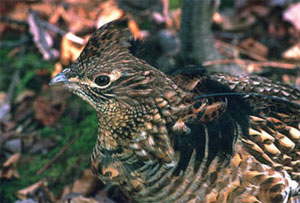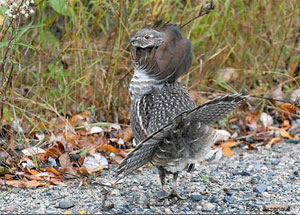Ruffed Grouse
(Bonasa umbellus)
Description & Range:
The Ruffed Grouse is a ground-dwelling, gallinaceous (chicken-like) game bird found in the forests of Western Maryland. Their plumage is complex but subtle, consisting of various shades of brown, black, and gray which blend perfectly into the leaves and twigs on the forest floor. Patches of dark black feathers on each side of the neck, called ruffs, are more prominent on males than females and can be erected for display purposes. Otherwise, plumage is similar between sexes. Two color phases exist; grey and brown, but brown-phase grouse are far more common in Maryland. A conspicuous black or dark brown band extends across their fan-like tail when displaying or flying. The weight of an adult grouse is around 1-1.5 lbs.

Ruffed Grouse are widely distributed across the North America, but their range in the Central and Southern Appalachians is primarily limited to higher elevation forests. In Maryland, grouse are most abundant in Garrett and Allegany Counties. Lower densities of grouse exist in Washington and western Frederick Counties, which is the easternmost extent of their range in Maryland.
Habitat:
Although habitat needs vary throughout the year, a nearly universal requirement for Ruffed Grouse is early-successional forest. Early-successional forests, or young forests, used by grouse are typically 5-20 years old and are present following a timber harvest, fire, or insect or storm damage. Grouse prefer young trees and brush for cover and food that is essential to their survival. Although large patches of early-successional habitat are used by grouse, the highest numbers of grouse are often found where forests of various ages occur in close proximity, creating a mosaic of habitat types and subsequent food sources. During the summer, grouse will use more open areas such and forest roads, openings, and field edges where protein-rich insects can be found.
Throughout most of the year, Ruffed Grouse feed on a wide variety of leaves, buds, and fruits of forest plants. Acorns, wild grapes, greenbrier berries, crabapples, and other fruits and seeds are among the most preferred foods in the fall and winter in this region. But they are adaptable and will readily forage on poorer-quality foods such as tree buds and mountain laurel leaves if more nutritious foods are unavailable. Young grouse feed heavily on insects for the first weeks of life but gradually transition to a plant-dominated diet.
Reproduction:
Breeding season begins in early-spring when male grouse can be heard drumming, a unique method of defending his territory against rivals and attracting willing females. Male grouse rapidly beat their wings at an increasing rate, like a quickening drum roll, while perched upon their favorite drumming log. The sound has been described as a tractor starting up in the distance and, once heard, it will not be mistaken for anything else in the forest. Hens will typically lay about 2 eggs per 3 days until a clutch of 9-14 eggs is complete. Nests are simple shallow depressions on the ground, usually at the base of a tree or under a log. Incubation lasts about 24 days and all the young will usually hatch within a few hours. The chicks are precocial, leaving the nest within a short time after hatching. Both the eggs and young grouse are exceptionally vulnerable to predation; usually less than 50% of nests successfully hatch and less than 50% of the chicks survive until the fall.

Male grouse on display,
photo by Rick Arsenault, Wikimedia Commons
Sounds:
The most commonly heard sound is the drumming sound produced by male grouse, but hens and young will communicate with various chirps and whistle-type calls.
Behavior:
Ruffed Grouse are generally solitary throughout most of the year. However, they will congregate near food sources, particularly if food is limited. Also, broods will stay together in early fall and it is not uncommon to find several grouse in a small area during September or October. They spend most of the daylight hours on the ground foraging, but roost in trees during the night. Grouse are very wary, equipped with keen eyesight and hearing. They are exceptionally adept at avoiding detection by predators (including humans), often remaining motionless and hidden until they erupt with a thunderous series of wing-beats that propel them out of danger within seconds. Other times, they will flush or run well in advance of approaching danger before they are seen.
Management:
Ruffed Grouse are managed as a small game species in Maryland. Click here to learn more about Ruffed Grouse management in Maryland.